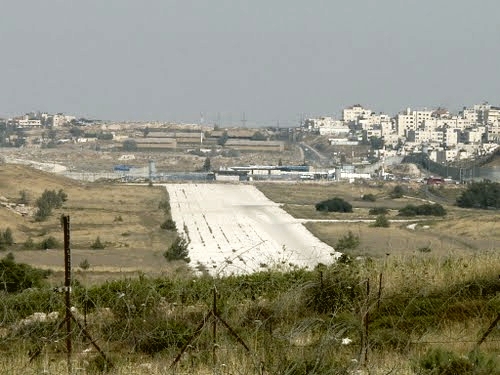April 22 2012 the Israeli army bulldozers started leveling lands and announced the confiscation of 400 dunums from Qalandiya village lands in order to build a new route of the Wall. The Palestinian village, located 11km north of Jerusalem and covering a total area of 3948 dunums, is already surrounded by a maze of Walls from three sides, divided by these walls into two separate parts and will now loose more land to facilitate the construction of a new Israeli settlement industrial zone on the area of the Qalandiya airport.
On February 22 2012, the Jerusalem Municipality approved the Israel Airport Authority’s petition to register the plot upon which the airport is built as official state land. Only one day later the Transportation Minister Yisrael Katz created a special committee to transfer Qalqandiya airport to Jerusalem municipality and use the land to expand the existing Atarot settlement industrial zone on this land.
The first confiscation of village land dates back to British mandate, when in 1920 village land was used to build an airport on 757 m2 with a runway of 1.965 km. Regular flights operated out of Qalandia Airport under British control in 1936 and continued under Jordanian administration and finally under Israeli rule. The flights stopped only during the second Intifada.
In 1970 the Israeli government established an industrial zone on lands of Qalandiya village, north of Jerusalem as part of their plan to transfer relatively polluting industrial plants to be closer to Palestinian neighborhoods. In order to achieve this goal, 1200 dunums were confiscated from both Beit Hanina and Qalandiya villages' lands and thus Atarot industrial zone was built. Today, Atarot covers an area of 1378 Dunums, contains more than 200 stores and factories, and is considered one of the three largest industrial zones in the West Bank, including companies such as Israeli Airspace Industries, Ashtrom, HeidelbergZement, Housing and Construction Holding – all with contracts and operations in EU member states.
The apartheid Wall marked the start of the third wave of confiscation of Qalandiya’s lands. It is built according to confiscation orders issued in 2006 and splits the village in 2 areas on either side of the Wall. In 2009, another part of the village lands were confiscated to build road number 45 (3 km) to connect between Qalandiya checkpoint (east of the village) and Givat Ze’ev intersection to the west of the village. Until December 2 2011 – for almost 5 years – people appealed against the path of the Wall and the split of the village. As a non sufficient result the Israeli army ordered the opening of a special checkpoint for the village so that people from both sides may reach each other. Now a new route of the Wall is to be built. However, taking into account all confiscations that Qalandiya has suffered, the villages is left with only around 1000 dunums from its original 3948 dunums.
The latest developments build on a lengthy Israeli effort to confiscate the area of the Qalandiya airport, which started more than a decade ago. In July 2001 the Airport Authority and the Defense Ministry signed an agreement on the army’s use of the Atarot [Qalandiya] airport that allowed the Israeli military to effectively take over the airport for its own use after it was shut down for civilian air traffic shortly after the start of the Intifada in October 2000. In late December 2007 Israel’s Housing Minister Ze’ev Boim announced that his ministry “was looking into building a new Jewish neighbourhood with 10,000 apartments in Atarot, located in east Jerusalem, to ease a housing crunch in the city”, according to Israel’s YNet website. A few months later, on April 11, 2008, an approval was given for 400 housing units to be built on lands of Qalandiya by the Israeli Jerusalem Mayor Uri Lupolianski. According to Arij, by July 2008, plans for the 11,000 proposed housing units for a Jewish settlement in Atarot have been put under study and review.
The annexation of the airport, the construction of the road network to link the settlements, as well as the expansion of the industrial zone all work together to reinforce the stranglehold on the northwest Jerusalem neighbourhoods, leading to direct and indirect expulsion of the population from their homes and their capital. It furthermore creates the necessary infrastructure for continued colonization and permanent annexation of the area as well as economic sustainability for the settlement project through industrial zones. Finally, Israeli particular interest in the airport area is likely determined as well by the urge to ensure any future Palestinian state can only be so by name and not de facto as it lacks the necessary sustainability and infrastructure for real statehood.

